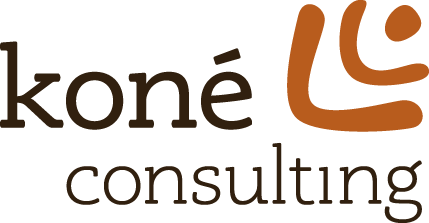Respect for people
At Koné Consulting, our thinking, teaching, and practice of lean begins with respect for people. We believe this critical component of lean is too often left behind, or buried beneath charters, charts, and flipcharts. Respect for people is also a direct pointer to one of the basic changes in mindset that must occur for lean thinking to stick in a team or organization, and to outlast our participation as consultants in any given engagement. We can give clients training and lean lingo; we can give them access to tools, methods, and forms; and we can practice using them by tackling problems impeding the fulfillment of their organization purpose—and that’s not enough. These changes won’t last unless they are supported by a culture change which involves people at every level of an organization.
Respect for people plays out in different ways for executives, managers, staff, or temporary workers, but it’s important for people in each role to put lean principles into practice. It may be practiced by a manager in how they respond to errors by figuring out how to build quality in at the source rather than rushing to “hold staff accountable”. It may be practiced by a supervisor who is focused on helping her direct reports develop their skills and authority (and notice the skills and authority they already have). It may be practiced by an executive when she communicates and champions the organization’s purpose, key value streams, and performance indicators with her boss or executive board. It may be practiced by anyone in the organization assuming good faith about the intentions of their colleagues, collaborators, and customers.
We facilitate improvement events with our clients to demonstrate how lean can work in government—and how lean “can work here”. The process of continuous improvement is the most noticeable aspect of lean: the whiteboards full of strange diagrams and notes in assorted handwriting, the excited chatter from a conference room, the disruption (however slight) of a group of peers piloting a countermeasure they’ve designed. Although the work is real, and the results can make a lasting difference for an agency and the people it serves, we see this as a form of practice. We encourage participants in value stream improvement workshops, kaizen events, and other lean processes to think about how it feels to be “inside” an event, and look for ways to make lean less special, and more ordinary, in their work.
Most adults are kinesthetic learners, so we hold to the see one, do one, teach one model—we challenge our clients to (for example) walk through a sample A3 with us, work through an A3 in order to remove a gap that they notice in their work, and then share the A3 with others as an approach to breaking down, communicating about, and removing problems. This applies equally to staff doing detailed improvement work as it does to management and leadership who must learn to distribute responsibility for improvement and adopt a coaching, rather than command and control, mindset. Practicing lean processes is the portal into developing the capability of everyone in an organization to participate in doing the work, and in improving the work.
It’s our experience that supervisors bear a difficult burden in a lean transformation. Their day-to-day work changes the most, and they are responsible for communicating ideas and practices that people may be unfamiliar with (or actively hostile to). Of course, lean management systems provide a basket of time-tested methods and practices that can help. The challenge is to get things started, and to help all levels of management in an agency understand that the tools of lean management are available, adaptable, and can help transform how staff see their work as it relates to their agency and the public it serves. Adapting to change is hard work, and supervisors must get out in front of the change—and are often under supported by their management and working with a skeptical staff.
At the end of this road is the organization’s purpose. What is the purpose of the agency? How does this purpose get fulfilled? How does—or could—the fulfillment of this purpose get measured, and communicated to stakeholders outside the organization? It is so empowering for staff to understand the purpose of their enterprise, and to see exactly how the difficult work they do every day contributes directly to that purpose. And we find no greater way for an organization to show respect for all of its people than to create space and methods for anyone to notice a problem, point out how it gets in the way of their purpose, and get support in seeing it as an opportunity for continuous improvement. People feel pain when they encounter waste, inefficiency, and poor customer service in their daily work. Fortunately, there’s a joy that comes from figuring out how to simplify, remove, or error-proof something order to better serve customers—both internal and external—that is easy to see in someone’s eyes once they experience it. The challenge is to make it stick: to get that fleeting epiphany in a small group to contribute to, and eventually to sustain, a culture of continuous improvement across a learning organization where the mindset of lean pervades daily work and planning.
